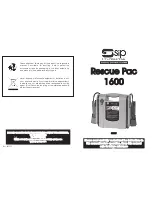
Page 36
OVP<
N
>?
Return the voltage trip setting of output <
N
>.
Response is VP<
N
> <
NR
2><
RMT
> where <
NR
2> is in Volts.
Note: If over voltage protection has been disabled the response is
VP<
N
> <
CRD
><
RMT
> where <
CRD
> is OFF.
OCP<
N
>?
Return the current trip setting of output<
N
>.
Response is CP<
N
> <
NR
2><
RMT
> where <
NR
2> is in Amps.
Note: If over current protection has been disabled the response is
CP<
N
> <
CRD
><
RMT
> where <
CRD
> is OFF.
V<
N
>O?
Return the output readback voltage of output <
N
>
Response is <
NR
2>V<
RMT
> where <
NR
2> is in Volts.
I<
N
>O?
Return the output readback current of output <
N
>
Response is <
NR
2>A<
RMT
> where <
NR
2> is in Amps.
DELTAV<
N
> <
NRF
>
Set the output voltage step size of output <
N
> to <
NRF
> Volts.
DELTAI<
N
> <
NRF
>
Set the output current step size of output <
N
> to <
NRF
> Amps.
DELTAV<
N
>?
Return the output voltage step size of output <
N
>
Response is DELTAV<
N
> <
NR
2><
RMT
>, where <
NR
2> is in Volts.
DELTAI<
N
>?
Return the output current step size of output <
N
>
Response is DELTAI<
N
> <
NR
2><
RMT
>, where <
NR
2> is in Amps.
INCV<
N
>
Increment the output<
N
> voltage by step size.
INCV<
N
>V
Increment the output<
N
> voltage by step size, with verify.
DECV<
N
>
Decrement the output<
N
> voltage by step size.
DECV<
N
>V
Decrement output<
N
> voltage by step size, with verify.
INCI<
N
>
Increment the output<
N
> current limit by step size.
DECI<
N
>
Decrement the output<
N
> current limit by step size.
OP<
N
> <
NRF
>
Set output<
N
> on/off where <
NRF
> has the following meaning:
0=OFF, 1=ON.
OP<
N
>?
Returns output<
N
> on/off status.
The response is <
NR
1><
RMT
> where 1 = ON, 0 = OFF.
OPALL <
NRF
>
By default simultaneously sets all outputs on/off where <
NRF
> has
the following meaning: 0=ALL OFF, 1=ALL ON. However this
behaviour can be changed to turn the outputs on or off in a timed
sequence or to omit an output entirely. See section 9.4 for an
explanation.
TRIPRST
Attempt to clear all trip conditions.
VRANGE<
N
> <
NRF
>
Set output<
N
> voltage range to <
NRF
> where <
NRF
> has the
following meaning:
Output1: 1= 16V/6A, 2 = 35V/3A.
Output2: 1= 35V/3A, 2 = 16V/6A, 3 = 35V/6A.
Output3: 1= 35V/3A, 2 = 70V/1.5A, 3 = 70V/3A.
VRANGE<
N
>?
Returns the voltage range for output<
N
>. The response is
<
NR
1><
RMT
> where <
NR
1> has the following meaning:
Output1: 1= 16V/6A, 2 = 35V/3A.
Output2: 1= 35V/3A, 2 = 16V/6A, 3 = 35V/6A.
Output3: 1= 35V/3A, 2 = 70V/1.5A, 3 = 70V/3A.










































